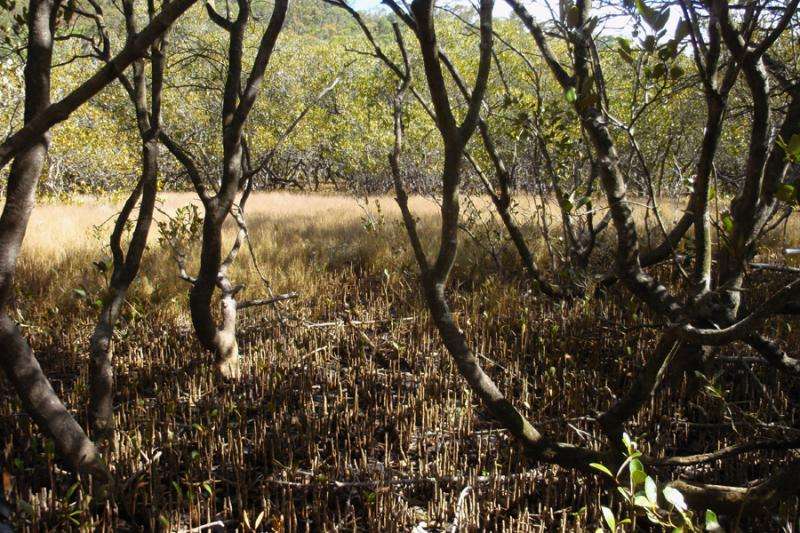March of the mangroves good news for blue carbon storage

The carbon capture and storage capacity of wetland vegetation, known as blue carbon, makes coastal habitats some of the most carbon rich ecosystems on the planet. A new study, published in Global Change Biology by Australian environmental scientists investigating the impact of shifts in coastal vegetation over a 70 year period, provides unique insight into how blue carbon stocks change in these dynamic and vulnerable environments.
The study supports Australia's aim to become one of the first countries to include blue carbon in its national emissions inventory.
Using historical aerial photos, together with field surveys and sediment core analyses, the research team tracked the continuous encroachment of mangrove forest into two NSW saltmarshes over a 70 year period. The researchers estimated that over the past 70 years, the expansion of mangroves into salt marsh habitat may have increased blue carbon storage by as much as half a million tonnes in NSW alone. This represents an important natural feedback against climate change and quantifies for the first time changes in carbon storage associated with widespread environmental change in these habitats.
"We now know that seagrass, mangroves and salt marsh habitats are more efficient at locking away carbon than rainforests. This 'blue carbon' resource is finally gaining recognition in carbon accounting efforts so it's very important to be able to quantify the changes that are taking place in a changing climate," says Jeffrey Kelleway, lead author of the study and a PhD candidate in the UTS Plant Functional Biology and Climate Change Cluster (C3).
Kelleway explained that the migration of mangrove forests into treeless saltmarsh ecosystems is a worldwide phenomenon that is expected to continue as sea levels and global temperatures rise.
"Our study tested whether this mangrove expansion into salt marsh habitat altered the long-term carbon storage capacity of coastal ecosystems. Attempts to quantify this type of change have been inconclusive so far because studies have only taken place in parts of the world where mangrove expansion has only become apparent in the past 30 years or so," Kelleway says. "Here in Australia we have a record in the aerial photos which shows mangroves have been expanding into salt marshes for at least the past 70 years."
Kelleway says the findings will offer insights relevant for other regions because changing climate is likely to shift mangrove encroachment from 'short-term pulses' towards longer term ecosystem change.
"In the southern states of the US for example, there are vast areas of salt marsh where mangroves are now expanding because of changes in winter climate. Historically cold winter snaps have kept the mangroves in check, but they now haven't seen decent frosts in those areas since the 1980s, which is allowing the mangroves to survive and compete with salt marshes."
In NSW, sea-level rise is considered a key factor in the migration of mangroves upslope into the higher elevation salt marshes. The researchers also found evidence to suggest that mangroves may be able to "build" the elevation of the wetland surface.
"Through the growth of their dense root networks, which itself is rich in carbon, mangroves expanding into salt marsh may also be able to survive rising sea levels and continue to capture carbon into the future," Kelleway says.
Future directions for ongoing research include the characterisation of the extra carbon being stored as mangroves expand.
"We want to know how much of it is carbon captured by the mangroves themselves through photosynthesis and how much of it is carbon washed in from the catchments and trapped by the mangrove roots."
More information: Seventy years of continuous encroachment substantially increases "blue carbon" capacity as mangroves replace intertidal salt marshes. Global Change Biology (2015), DOI: 10.1111/gcb.13158
Journal information: Global Change Biology
Provided by University of Technology, Sydney
















